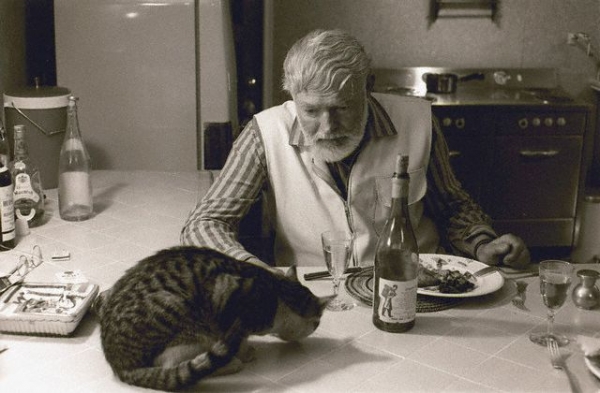UNITED STATES—At different times in his storied life Hemingway had two modes of eating: he ate to live and, other times, he unabashedly lived to eat.
When he ate, he ate to live, while at work or in war, food was a means to an end. “Not something to be fussed over,” writes Redd Griffin a writer from the author’s native Oak Park, Illinois. “When he lived to eat, food became something worthy of careful preparation and contemplation.” Such as when he was roaming the cafes and brasseries in Paris in the 20s and the sophisticated food, described in startling sensuous detail and sometimes with the hilarious one-up of the connoisseur’s connoisseur, became a means to connect people.
In Hemingway’s food style there dwelled both the Spartan and the hedonist. From his dad Hemingway absorbed a pragmatic, Spartan, resourceful pioneer attitude. The first settlers in Illinois built log hunted and fished for their own food, an endeavor which not only required all the senses but also sharpened them. Anything you hunt or pick for yourself tastes special, and it has been observed that Hemingway’s appetite was truly piqued when hunting or fishing for marlin. In “The Hemingway Cookbook,” Craig Boreth notes:
“As with all of his great passions—the bullfights, fishing for trout or marlin, or writing well—the heightened reality of the hunt awakened in Ernest that voracious appetite for food and drink.”
When camping and getting the kids out of the suburban enclave of Oak Park. Hemingway’s father, a doctor and outdoorsman, showed his children how it was done. One of Hemingway’s sisters recounts in a memoir that when supplies ran low her father “shot some partridge and a few squirrels, coaxed honey from a bee’s nest, and whipped up a meal of fried game, biscuits and blackberry pie.” (It sounds mouth watering in the wilds).
His father introduced Ernest to the outdoors. Ernest spent much of his childhood with his father, other family and friends in the wooded hills of northern Michigan, scene of his 1921 story, “Up in Michigan,” that still has the power to shock. Here his father showed him the ropes of hiking, camping, fishing and hunting.
“His father Ed taught Ernest to closely observe important sights and sounds in the wild,” Griffin writes. “After cooking local game, Ed blindfolded Ernie to see if he could identify it after tasting it. Ed further taught him how to skin, clean and cook what they caught or killed.”
These lessons carried directly over to the lean early times in Paris, then a good cheap place to live for Americans because of the favorable exchange rates. Ernest Hemingway frequented the Luxembourg Gardens, the Griffith Park of the Left Bank. He hung out around the Medici Fountain and around closing time Ernest would grab and strangle a pigeon, and smuggle it out of the gardens hidden in the baby carriage with his son.
Hemingway was a carnivore. No surprise there. Given his druthers the barrel-chested, six foot Hemingway, would have be a carnivore the way vegans are vegetarian. “When I was a small kid I would eat only meat and fish,” Hemingway wrote his publisher in the early 1950s. And in fact his enjoyment of meat and shellfish remained a culinary constant. In his African Journal, written in his last decade and published as “True at First Light,” the Hemingway in the fictionalized memoir loves milk, game, fish, and wild berries, and will eat no vegetables except corn roasted in the ashes of an open fire.
But as a schoolboy Hemingway painfully learned why it might be helpful to eat vegetables. Once when he clung to his preference for meat and would not eat vegetables, “no matter how much they whipped me,” he became constipated. He couldn’t go for nine days. Then he got cramps while at a track meet and was finally able to go. The Paul Bunyonesque results required the services of a plumber to clear. The lesson Hemingway drew from this, “I knew I had to learn to eat vegetables and to move my bowels.” Yes, even the great Hemingway knew to eat vegetables and had his own way of spelling bowels.”
To be continued…
Humorist Grady Miller is the author of “Lighten Up Now: The Grady Diet.” He can be reached at grady.miller@canyon-news.com.






